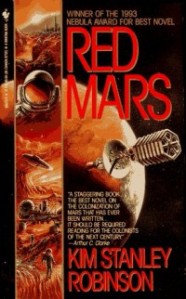Ever gotten a few pages into a book and recognized something you learned about from Kerbal Space Program? I didn’t realize how awesome that would feel until I read The Martian.
Some time in the near future, NASA has organized a manned Mars space program. The first two Ares missions go off without a hitch. On the third, a freak dust storm on the surface of Mars forces the crew to ditch the mission early. An antenna breaks off in the wind and impales astronaut Mark Watney. He goes down and his suit’s vital signs blink out. The rest of the crew don’t have time to recover the body, so they leave.
There’s a problem. Mark Watney’s still alive.
Just … how did Andy Weir manage to make a space disaster thriller hilarious? Watney accepts the fact that he’s probably going to starve to death with surprising aplomb. His mission log entries are the high point of the book. The book’s told in a highly unconventional mix of first person (Watney’s snark), third person (NASA officials, who are freaking out), and omniscient (what’s going on with equipment and unmanned probes). Weir shouldn’t get away with it, but he does because it’s so very entertaining.
You’ll want to read this book if you want to know how a manned mission to Mars would work. Weir’s thought the details through. This book sent me to Wikipedia a lot, and while I don’t understand all of the science, it’s rock-hard. Yet it’s not dry and technical. Weir manages to make nail-biting tension out of Hohmann transfer windows.
If you wanted to know what a mission to Mars would look like, though, you won’t find out here. For example, here’s a description of the Hermes, the spacecraft the Ares crew used to get to Mars:
The Hermes crew enjoyed their scant personal time in an area called “The Rec.” Consisting of a table and barely enough room to seat six, it ranked low in gravity priority. Its position amidships granted it a mere 0.2g.
This is the most extensive description of the Hermes in the book. The Martian surface doesn’t fare much better.
I also have a pet peeve about Vogel’s broken English. His grammar is ridiculously bad for someone who has spent months of mission time and years of training time using English exclusively to communicate. If NASA had caught him saying things like “Very important is thirteen centimeters,” they would have kicked him off the mission.
But that’s a minor point. The Martian is the most entertaining hard science fiction I’ve read in a long time.
Edit: NASA just announced they found evidence of liquid water on Mars. The timing couldn’t be better.


